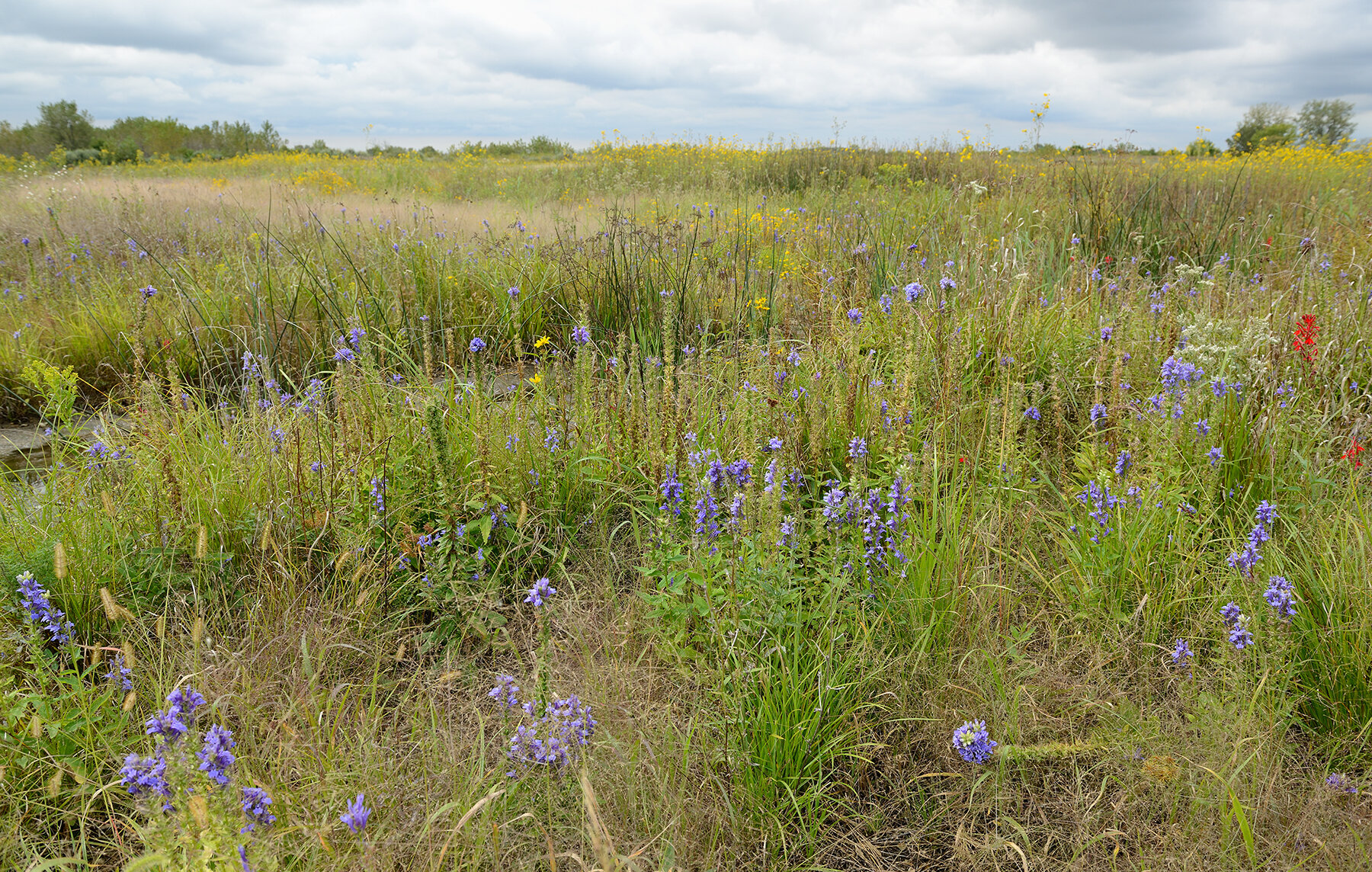The Wetlands Initiative has been a core restoration partner at Midewin nearly since the site’s designation as the country’s first National Tallgrass Prairie 25 years ago. Since 2001, when our habitat restoration efforts there really ramped up, TWI has worked in partnership with the U.S. Forest Service on restoring eight distinct parcels of land across a total of 3,376 acres on Midewin’s west side. As we celebrate Midewin’s silver anniversary this month we’re taking a walk down memory lane, looking at some of the highlights of what we’ve accomplished so far to transform this former U.S. Army arsenal, including the huge Glacial Plains Prairie project that’s now underway.
TWI’s completed and current restoration projects at Midewin (click to enlarge map). Map by Jim Monchak/TWI.
Back in 2001, TWI first began intensive work at Midewin on two parcels known as Blodgett Road and South Patrol Road, both named after roads that crossed the site during its time as the world’s largest munitions plant. Blodgett Road, a 289-acre parcel in the northwest corner of Midewin, had shallow soils that enabled the restoration of globally rare dolomitic habitats, where dolomite bedrock occurs close to the surface and only specially adapted plants can flourish. To start, we eliminated rapid drainage from the site by removing drain tiles, filling ditches, and changing the topography to reestablish more natural water patterns. We then controlled invasive plants and trees and reintroduced native species to augment the remaining dolomitic plants. Today the dolomitic prairies and wetlands at Blodgett Road are thriving.
Before its restoration, the 464-acre South Patrol Road parcel contained abandoned farm fields interrupted by man-made hedgerows, a massive drainage ditch, and a rail line. TWI removed a huge number of invasive plants and aggressive trees and filled the roughly 30-foot-wide ditch. At the same time, the Forest Service planted the site with soybeans, a technique used to establish a “blank slate” for later plantings of natives. South Patrol Road’s prairies and wetlands are now one of the highest-quality restored areas at Midewin. This public–private partnership received a Habitat Conservation Award in 2007 through the U.S. Forest Service’s “Wings Across the Americas” program as well as a Conservation and Native Landscaping Award in 2013 from Chicago Wilderness.
Another TWI project notable for its land-use history is Lobelia Meadows, where we worked from 2012 through 2016. Lobelia Meadows was once the site of the arsenal’s sewage-treatment facility. Removal of earthen berms, concrete, steel pipes, and other infrastructure was needed before habitat restoration could begin there. This intensive “waste to wildflowers” project paid off: Pre- and post-restoration plant monitoring found that the total number of native plant species increased from 63 in 2012 to 116 just four years later. During the same period, the extent of native species coverage increased from 37% to 76% of the parcel.
Lobelia Meadows before restoration. Photo by Gary Sullivan/TWI.
Lobelia Meadows after restoration. Photo by Gary Sullivan/TWI.
At 160 acres, Lobelia Meadows had an outsize importance for another reason: It was the missing puzzle piece needed to create a contiguous corridor of restored areas on Midewin’s west side, linking three other parcels together. “The opportunity to restore large, connected tracts of native habitat is what makes restoration at Midewin so special,” said TWI Senior Ecologist Dr. Gary Sullivan, who has designed all TWI’s Midewin projects in close collaboration with Forest Service staff. “Illinois has lost more than 99.9% of its pre-settlement prairie, and the little that remains is found in relatively small, isolated fragments. Restorations of large mosaics of prairies and wetlands at Midewin’s scale are exceedingly rare, but they are critical for the survival of many rare or threatened plants and animals.”
TWI’s successful partnership with the Forest Service at Midewin has grown even more since Lobelia Meadows. In 2016, we began a seven-year, 1,936-acre restoration effort in partnership with the National Forest Foundation and conservation funders the Grand Victoria Foundation and the Gaylord & Dorothy Donnelley Foundation. Now in its fifth year, the Glacial Plains Prairie project will ultimately double the acreage of restored habitats on Midewin’s west side and link up all TWI’s previously restored parcels.
“This seven-year project—bigger than anything TWI has done before at Midewin—was made possible through years of deep collaboration,” said Paul Botts, TWI’s executive director. “It’s just one example of how all the stakeholders are working together ever more closely to realize Midewin’s full conservation potential for the Chicago region. And there is so much more to be done.”
A Great Blue Heron in the restored South Patrol Road wetlands. Photo by Gary Sullivan/TWI.
These restoration achievements benefit many of our area’s imperiled wildlife species, unique birds, rare plants—and you too! Several of TWI’s projects are already open to the public with hiking trails. Sometime during Midewin’s 25th-anniversary year, take a walk through the blooming wildflowers and vibrant wetlands, watch for Great Blue Herons and Bobolinks, and savor the experience of the largest prairie-in-restoration in the Prairie State.
Visitors to Midewin can find maps and other information here.



